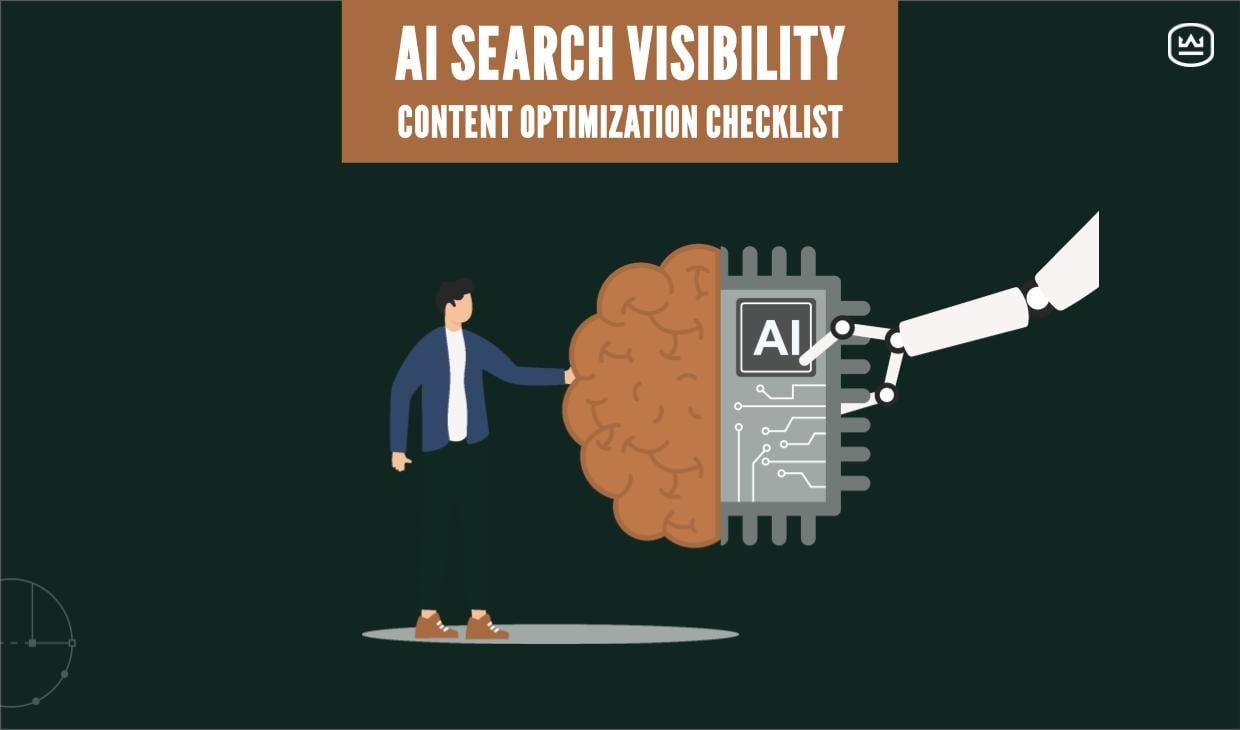How Falcon Rebuilt Industrial AI Search Visibility: Lessons From the Front Lines
Written by
For years, Falcon Structures had one of the most disciplined inbound engines I’d ever worked with. Weekly blogs. Rigorous keyword strategy. Clear alignment between marketing and sales. And for a long time, it worked exactly the way our playbooks said it would.
Then 2024 happened.
Traffic fell. MQLs dipped. Blog performance flattened. And yet, in every conversation I had with Krista Short, Falcon’s VP of Marketing & Sales, the same surprising truth held steady: the leads that truly mattered weren’t declining.
Something else was happening, and it wasn’t a failure of effort or execution. It was a shift in how industrial buyers discover solutions in an AI-driven world.
This episode of The ChangeOver reflects the journey the Falcon and Weidert Group teams went on together — questioning assumptions, letting go of old habits and rebuilding a strategy grounded in deeper audience understanding.
Watch episode 31 of The ChangeOver, then subscribe on Apple, YouTube, Spotify, Weidert.com, or your favorite podcast app.
What is AI Search Visibility?
If SEO was about ranking for keywords, search visibility in the AI era is about being ingested, understood, and surfaced by AI systems across the entire discovery ecosystem.
Today’s industrial buyer:
- Skims less
- Asks more
- Looks for context instead of keywords
- Relies on AI platforms to synthesize answers
- Trusts authoritative entities over one-off content pieces
That means your brand needs to be:
- Discoverable beyond Google
- Present in the sources AI systems rely on
- Consistent across multiple structured formats
- Built around problem-first, not keyword-first, content
Our work with Falcon serves as a real-world case study in how industrial marketing teams can operationalize this shift.
When Falcon Recognized the Model Needed Adjustment
There’s a meeting I remember: Krista and I reviewing month-over-month trends, both of us looking at the sharp drop in organic traffic and thinking, this doesn’t match what we’re hearing from sales.
And she said what we were all thinking:
Traffic really took a pretty big tumble… so, what’s happening?
Despite the drop, Falcon’s sales-qualified leads and revenue stayed solid. That told us we weren’t losing our audience; we were losing the old pathways they used to take to find us. That realization became the turning point.
Major Shift: From Keyword Optimization to AI Search Strategy Development
For years, Falcon had a healthy inbound engine grounded in traditional SEO: weekly blogs, keyword clusters, long-form educational content. And, to be candid, they executed it well.
But AI search changed the rules. AI platforms don’t reward frequency; they reward clarity, authority and structure. So we paused weekly blogging and rebuilt around three pillars of modern AI search strategy:
- Deep audience intelligence: We blended SEO performance data, persona-based clickstream data, frontline sales insights, and category-specific questions buyers were asking in search.
- Topic ecosystems (not isolated posts): Instead of 4–5 new blogs a month, we built fresh, deep resource hubs around Falcon’s highest-value commercial-intent topics.
- Visibility where AI systems actually look. This included sources like:
- Wikipedia (yes, really)
- Industry registries and data repositories
- Trusted trade media
- Off-site content with strong entity and trust signals
- Owned multimedia content aligned with structured markup
Falcon’s category, modular structures built from repurposed steel shipping containers, has always required context-rich explanations. Many people evaluating these solutions have specific operational problems, employee needs, and regulatory constraints. And because repurposed shipping container buildings are a nontraditional solution in the construction space, customer searches often begin with a problem, not a product.
When AI-driven search began surfacing answers built on conversational logic rather than exact-match keywords, our advantage became clearer.
“It all really just comes back to the customer… rather than trying to pinpoint these very strategic keywords.” — Krista Short, VP Marketing & Sales, Falcon Structures
So as a team, we began shifting focus from, “What keyword do we need to win?” to, “What problem is the buyer trying to solve?”
And just as importantly, “Where are they going now when they ask those questions?”
Why Industrial Brands Need AEO Strategy, and How Falcon Built Theirs
Most B2B teams are still optimizing for search engines, rather than answer engines. Falcon took a brave leap forward into the answer engine space, and that calls for an answer engine optimization strategy.
First, what’s an answer engine? In this context, an answer engine is any system that synthesized a direct answer rather than serving up a list of links like the SERPs of yore:
- AI chat interfaces like ChatGPT, Claude, Gemini, Perplexity, Grok, etc.
- AI-injected search experiences including Google’s AI Overviews, Bing Copilot mode, and Perplexity’s blended results, which show links within the primary output
AEO strategy for B2B requires:
Direct, answer-first content structures. AI systems favor content that resolves core queries in the first sentence or two.
Structured entities and contextual relationships. Industrial AI search visibility improves when your brand is tied to:
- Defined products
- Defined applications
- Defined industries
- Clear, repeated contextual markers
Content that exists in multiple structured formats. Text alone is no longer enough. Falcon invested in:
- Video explainers
- SME audio clips
- LinkedIn carousels
- Long-form narrative content
- Structured markup and schema
A single narrative built across formats. This is how authority is built in AI-driven search.
Falcon didn’t try to create more content; they created more connected, coordinated content, with a holistic plan to get it in front of prospects in multiple places.
RELATED: The New Search Visibility Checklist for AI-Era Content Marketing
Search Visibility Playbook: Rebuilding Falcon’s Discovery Engine
Before Falcon made the strategic shift toward holistic search visibility, a typical month looked like:
- Four weekly blogs
- Keyword-driven topic selection
- TOFU content designed to pull traffic
- Little repurposing beyond social distribution
Today, it looks different (and healthier):
- Deep resource hubs built around priority commercial-intent topics
- Video-first assets, SME audio, LinkedIn carousels and repurposed clips
- Content ecosystems created once, then reused across formats
- Topics chosen through customer conversations, not editorial calendars and keyword math
From my vantage point, this is the change that matters most: instead of spreading effort thinly across 12–15 disparate topics, we concentrate on building depth and true authority around the questions that actually drive Falcon’s pipeline toward sales. That’s better for performance in search systems, but it’s also better for real humans.
“Why not use it, reuse it, put it out in different ways? Everyone consumes content differently.” — Krista Short
Why Measurement Had to Change, and What Falcon Did Differently
Inside Falcon, website traffic had always been the steady, go-to indicator of whether marketing was working. After all, for years, strong top-of-funnel performance reliably translated into stronger sales outcomes. But when traffic dropped in 2024 and sales-ready leads didn’t, we had to pause and reconsider what “good” looks like in an AI-driven landscape. Krista articulated it perfectly in one of our early conversations about the shift:
“It’s okay that the traffic has gone down; let’s shift KPIs toward the bottom of the funnel.” — Krista Short
That became the permission we needed to redefine success. If buyers were still finding Falcon — just through new pathways — then our metrics needed to reflect those pathways, not the ones we were used to.
So we rebuilt the measurement model around signals that actually indicate intent and commercial value today. That meant paying attention to things like:
- Commercial-intent engagement — how users interact with deeper, product-aligned content that reflects active problem-solving, not casual browsing
- Topic-level visibility across discovery surfaces — whether Falcon appears consistently wherever buyers ask questions — in search engines, AI systems, third-party directories, and industry-specific platforms
- Entity stability in AI environments — how clearly AI systems recognize Falcon, its products, use cases, and brand attributes — a critical component of AI-era visibility
- Time saved through content consolidation — a practical but meaningful metric. Creating fewer, deeper pieces meant freeing resources that could be redirected toward experimentation and strategy
- Sales readiness signals — behaviors that indicate someone is close to engaging a sales conversation, which are far more predictive than raw traffic
- Overall revenue influence — the aggregate picture of which topics, assets and discovery points actually show up in closed-won stories
Taken together, these metrics give us a far more accurate read on whether Falcon’s strategy is working. They reflect how people buy today, not how they bought five years ago. More importantly, they help us stay focused on business impact — because traffic alone simply doesn’t tell the story anymore.
Advice and Lessons From the Field
At one point in our conversation, I asked Krista what she’d tell another leader navigating this same shift. She didn’t hesitate:
“Be open to trying new things… don’t be scared. Don’t be afraid. It’s going to be okay.” — Krista Short
I’ve worked with Falcon for a long time, and their team approached this upheaval with curiosity instead of fear. That openness made it possible to rebuild a stronger, more modern strategy grounded in real audience understanding and true commercial intent.
Working alongside Falcon through this shift reinforced something I now believe deeply:
Industrial AI search visibility isn’t something you achieve. It’s something you build … deliberately, continuously, collaboratively.
Subscribe To Our Blog
Information. Insights. Ideas. Get notified every time a new Weidert Group blog article is published – subscribe now!
You May Also Like...

Search Engine Optimization
How Falcon Rebuilt Industrial AI Search Visibility in 2025

Search Engine Optimization
The New Search Visibility Checklist for AI-Era Content Marketing

Search Engine Optimization
SEO Isn’t Dead. It’s Evolving: How B2Bs Can Stay Visible in the Age of AI
Accelerate Your Growth with
Weidert Group
If you’re ready to explore a partnership, request a personalized consultation with our team.

